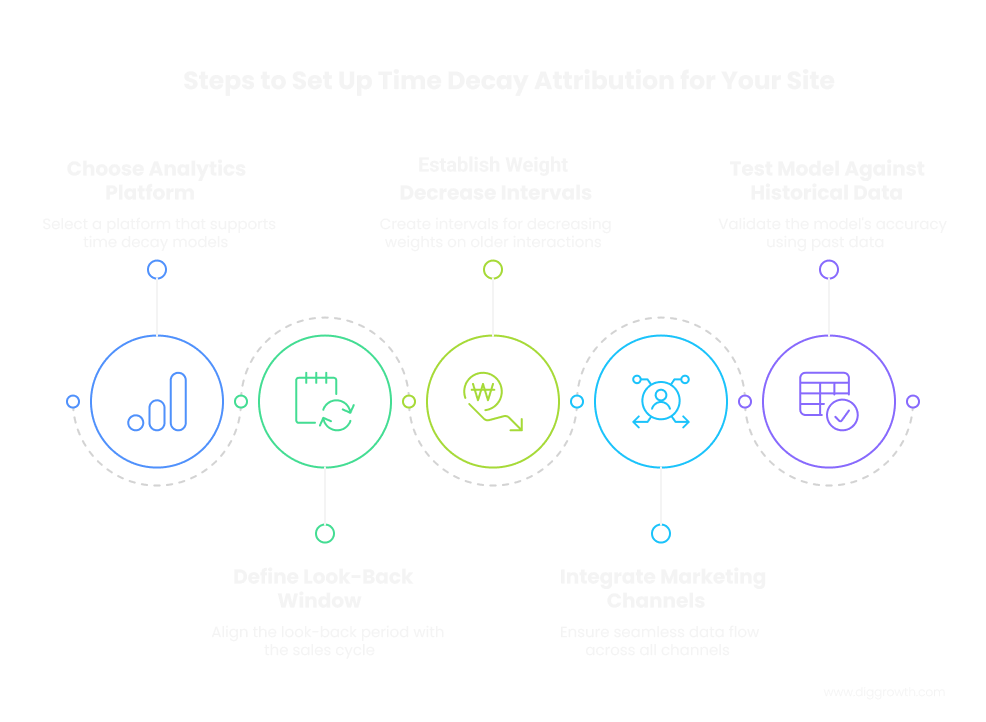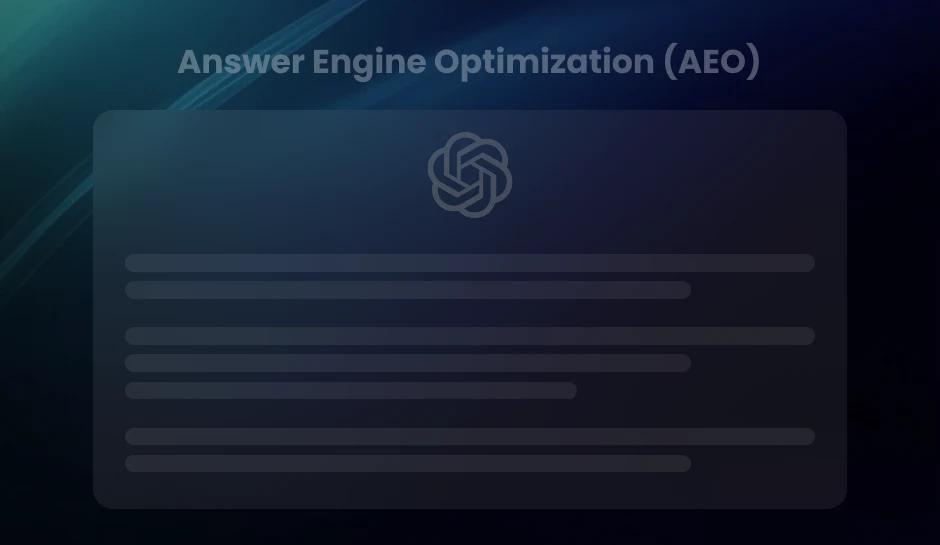
Mastering Time Decay Attribution: Navigating the Dynamics of Marketing Success
Time Decay Attribution helps marketers assign credit to touchpoints closer to conversion, providing a more accurate view of campaign performance. Learn how this model improves ROI, refines budget allocation, and integrates with machine learning for smarter marketing decisions.
Today, attribution serves as the compass that guides decision-makers in understanding which touchpoints lead consumers to take a desired action, such as making a purchase or signing up for a service. By tracing the customer’s journey and identifying what influences their decisions, marketers optimize future efforts for more effective outcomes.
Time decay attribution emerges as a nuanced paradigm within this sphere, prioritizing recent interactions by assigning them more credit for conversions than earlier ones. This model operates under the premise that the closer in time a marketing touchpoint is to the conversion event, the more influence it has had on the consumer’s decision.
Transitioning between channels and marketing stimuli, time decay attribution maps out a weighted path that progressively accentuates the importance of interactions as they approach the conversion point.
Deciphering the Impact of Time Decay Attribution
Time Decay Attribution allocates an increasing amount of credit to touchpoints closer in time to the conversion event. This model acknowledges that a customer’s decision to convert is influenced more by recent interactions than by initial ones.
Better Representation of the Customer Journey
The path a customer takes from awareness to conversion is seldom a linear one. Time Decay Attribution provides marketers with a granular view by attributing more credit to touchpoints closer to the conversion, thus mapping the journey with greater precision.
Reflecting the Value of Each Touchpoint Over Time
Every customer engagement with a brand plays a role in shaping their purchasing decision. However, not all interactions hold equal weight. Time Decay Attribution recognizes the variable impact of each engagement by valuing recent interactions more significantly, offering a dynamic portrayal of touchpoint efficacy.
- By tailoring the attribution weights, Time Decay Attribution ensures that the contributions of touchpoints are properly recognized at each stage of the marketing funnel.
- This model acknowledges that while earlier interactions build awareness, it is often the later ones that reinforce and trigger the decision to purchase.
An understanding of Time Decay Attribution enables marketers to optimize campaigns, redistribute budgets, and fine-tune strategies to engage with the audience at the most effective points in their decision-making process.
Delving Into Marketing Analytics and Attribution Modeling
Marketing analytics encompasses the processes and technologies that enable marketers to evaluate the success of their marketing initiatives. Attribution modeling is a key component, as it assigns credit to different marketing touchpoints throughout a consumer’s journey to purchase. Marketers rely on various attribution models to inform their decisions and optimize marketing strategies.
Overview of Different Attribution Models
In the landscape of attribution, marketers encounter a spectrum of models, each offering unique perspectives on assigning conversion credit. Single-touch models credit a single touchpoint, either the first (first-touch) or the last (last-touch) interaction before conversion. Conversely, multi-touch attribution (MTA) recognizes that multiple touchpoints contribute to conversion and distribute credit across different customer interactions.
Last-Touch vs. First-Touch Attribution
Relegating the success of a conversion to the final interaction before a sale, last-touch attribution overlooks the entire journey a customer undertakes. Simultaneously, first-touch attribution attributes full conversion credit to the initial engagement, which can discount subsequent influential interactions.
Multi-Touch Attribution (MTA)
Multi-touch attribution acknowledges the complexity of the conversion path by allotting credit to several touchpoints that led to a conversion. This model provides a more nuanced view compared to single-touch models, reflecting the multifaceted nature of modern consumer journeys.
Weighted Attribution and Time Decay Attribution
Different weighted attribution approaches exist, with time decay attribution standing out for factoring in the timing of interactions. Time decay models assign incremental credit to touchpoints closer in time to the conversion, underpinning the rationale that certain actions have a more immediate impact on decision-making.
How Time Decay Attribution Fits into Marketing Analytics
Time decay attribution merges perfectly into the intricacies of marketing analytics. By emphasizing recent interactions, this model assists marketers in understanding and valuing the touchpoints that drive conversions more imminently. The dynamic nature of this model resonates with the fast-paced decision cycles characteristic of today’s consumers.
- Multi-touch models like time decay are increasingly relevant in a digital ecosystem replete with touchpoints.
- Time decay attribution empowers marketers to prioritize channels that secure conversions within closer timeframes.
- Integrating time decay into marketing analytics frameworks allows for more agile and responsive marketing strategies.
Pro Tip- Leverage time decay attribution in your analytics to fine-tune budget allocation—prioritize channels and touchpoints that drive conversions closer to the decision-making moment for maximum impact.
Dissecting the Time Decay Attribution Model
The mechanics of Time Decay Attribution revolve around the concept of half-life. This concept, borrowed from physics, describes the period it takes for a quantity to reduce to half its initial value. In marketing analytics, the half-life is the time frame during which the effectiveness of a marketing touchpoint is considered to diminish by half. This decrease encapsulates the temporal aspect of impression and potential conversion influence.
Assigning decreasing credit to touchpoints as time elapses is central to Time Decay Attribution. When a customer interacts with various marketing initiatives, each interaction or ‘touchpoint’ receives a portion of the credit for any eventual sale or conversion.
The touchpoints closest in time to the conversion gain more credit, reflecting their greater immediacy and presumed impact. Conversely, earlier touchpoints receive less credit, acknowledging that their influence wanes over time.
Digital marketers typically apply a weighted distribution, where the most recent touchpoint might receive the largest share of the credit. Each prior interaction’s credit share decreases incrementally according to the set half-life. This distribution mirrors the diminished recall and relevance of distant marketing efforts.
- Immediately proceeding actions are weighted heavily, reinforcing their supposed influence on decision-making.
- Intervening touchpoints have a sliding scale of impact, balancing temporal proximity and diminishing returns.
- Initial engagements may bear minor attribution, yet they set the foundation for subsequent marketing effectiveness.
Through these decrements, Time Decay Attribution acknowledges that the combination of touchpoints culminates in a conversion. This model accounts for both the timing and the cumulative effect of marketing efforts, providing nuanced insights into campaign performance.
Direct questions often probe into the specifics of Time Decay models, such as the optimal half-life for most businesses. While there is no universal prescription, marketers typically adjust the half-life in the Time Decay model to match the sales cycle of their products or services.
Shorter sales cycles may call for a rapid decay rate, whereas longer cycles might justify an extended half-life, rendering earlier touchpoints more significant than they would be with a shorter half-life.
Pro Tip- Customize the half-life in your Time Decay Attribution model to align with your sales cycle—shorter cycles require a steeper decay, while longer cycles benefit from a more gradual credit distribution.
Enhancing Channel Analytics through Time Decay
Evaluating the performance of various marketing channels delivers insights that lead to a more sophisticated allocation of advertising budget. Time decay attribution plays a pivotal role in this analysis by assigning more credit to the interactions that occur closer to the time of conversion. This reflection of diminishing influence over time enables marketers to discern the channels contributing effectively to the end goal versus those that may just be along the consumer’s path to purchase without a demonstrable impact.
Inherent complexities arise within cross-channel marketing efforts. Consumers often touch multiple channels, from social media to email campaigns before converting. Time decay attribution provides a refined look at this interplay by offering granularity on how the timing of these interactions influences the eventual conversion. With this model, you can differentiate between a social media ad that initiates brand awareness and a targeted email that triggers a purchase decision.
- By analyzing the touchpoints through a time-decay lens, businesses can gain visibility into which channels deserve further investment.
- Strategies can be adjusted to optimize those channels that consistently appear at the decisive end of the customer journey.
- Inversely, channels that only appear early on with little to no presence near conversion can be scaled down or re-strategized.
Deploying time decay attribution transforms standard channel analytics into a dynamic framework that underlines the temporal relevance of marketing interactions. This allows for a more informed strategy where budget allocation is concerned, sharpening the focus on channels that drive conversions.
Pro Tip- Use Time Decay Attribution to refine budget allocation—invest more in channels that drive late-stage conversions while reassessing early-stage channels for improved engagement strategies.
Conversion Tracking and Time Decay Attribution
Understanding the influence Time Decay Attribution has on conversion tracking metrics unveils the nuanced journey customers undergo before completing a desired action. By assigning greater value to interactions closer to the point of conversion, businesses can calibrate their analytics for a more accurate reflection of each touchpoint’s effectiveness.
Traditional conversion tracking tends to credit the last interaction; however, this model refines the process, acknowledging that recent engagements often contribute more significantly to the final decision than earlier ones do.
By scrutinizing the path to conversion through the lens of Time Decay Attribution, marketers unravel the layers of customer behavior. This insight enables the identification of patterns that might otherwise go unnoticed when considering the multi-touch journey.
For instance, a user may click on several paid ads before eventually purchasing an organic search. While each of these interactions plays a role, Time Decay Attribution adequately recognizes the organic search’s pivotal role in driving the final sale.
- The first touchpoint starts the consumer on their path, serving as an introduction.
- Intermediate interactions maintain and build interest or engagement with the brand.
- Final touchpoints typically have the highest chance of converting interest into action.
A multichannel marketing strategy, empowered by this method, attributes conversion value dynamically. This dynamic allocation ensures that strategic adjustments to marketing efforts are based on up-to-date, actionable data, optimized for recent customer behavior trends. The granularity of data provided by Time Decay Attribution enables marketers to fine-tune campaigns and improve their strategies systematically.
Conversion tracking metrics adjusted for Time Decay Attribution present an evolved understanding, steering marketers away from potentially misleading data that doesn’t account for the temporal aspects of the customer journey. Acknowledging the diminishing impact of touchpoints over time drives a clearer allocation of marketing resources to channels most effective in the immediate run-up to conversions.
Pro Tip- Combine Time Decay Attribution with A/B testing to validate which touchpoints drive the most impact near conversion—ensuring data-driven refinements in marketing strategy.
Time Decay in the Context of Customer Journey Mapping
When analyzing the path a customer takes toward a sale, tracking each touchpoint provides valuable insights. Customer journey mapping visualizes this process, revealing how consumers interact with marketing channels. By incorporating time decay into journey analysis, professionals gain a nuanced understanding of which interactions have the most influence as the purchase event nears.
Mapping and Visualizing the Customer’s Path to Sales
Through visual representations, customer journey mapping uncovers every phase a customer experiences, from awareness to consideration and finally to the decision stage. By documenting these phases, marketers discern patterns and commonalities among successful sales journeys.
Including Time Decay in Journey Analysis for Better Insights
Including time decay within this analysis framework acknowledges that the closer in time a touchpoint is to the conversion, the more significant it is likely to be. This perspective leads to attributing greater value to marketing efforts that occur near the point of sale, thereby refining the allocation of advertising budgets and resources for future campaigns.
Employing time decay signals a shift away from oversimplifying attribution to recognizing the complexity of consumer interactions over time. By doing so, businesses can tailor their marketing strategies to engage customers more effectively during the critical moments leading up to a purchase.
Pro Tip- Use heatmaps and flowcharts alongside Time Decay Attribution in customer journey mapping to visually pinpoint high-impact touchpoints and optimize marketing efforts accordingly.
Time Decay Attribution and Data-Driven Decision Making
Utilizing data harnessed through time decay attribution transforms how marketers craft and adjust their strategies. They no longer rely on guesswork or gut feelings; the insights gained enable precision in identifying which touchpoints contribute most effectively to conversions over time. In consequence, marketing decisions become highly informed, with budget allocations and campaign adjustments reflecting a clear understanding of touchpoint value.
Beyond just informing marketing decisions, the interplay between attribution data and machine learning opens up new horizons. Machine learning algorithms digest vast sets of data, including time decay attribution models, to predict future customer behavior.
This powerful synergy allows marketers to anticipate trends, personalize customer experiences, and optimize campaigns continuously with increasing accuracy as more data is collected and analyzed.
- Data-driven decisions propel strategic refining of marketing initiatives that are aligned with consumer behavior patterns.
- Attribution data, once integrated with machine learning, can predict outcomes with higher certainty and less risk of costly missteps.
- The continuous loop of data feedback transforms marketing into a proactive rather than reactive discipline.
Attribution information does not operate in isolation; when marketers collate data from various models, including time decay, they gain a multi-dimensional view of engagement and influence. This comprehensive perspective ensures that future marketing efforts are not only robust but intricately tailored to each unique customer journey, optimizing the return on investment in the long run.
Pro Tip- Combine Time Decay Attribution insights with AI-driven predictive analytics to forecast customer behaviors and fine-tune marketing strategies for maximum conversion impact.
Calculating ROI with Time Decay Attribution
Return on Investment (ROI) analysis undergoes refinement when Time Decay Attribution is integrated. This model acknowledges that touchpoints closer to conversion hold more significance. By weighing the touchpoints differently, marketers can determine the precise impact of specific channels in the conversion process. The weighted contribution from each touchpoint then leads to a more nuanced understanding of the allocation of marketing dollars.
Incorporating Time Decay Into ROI Analysis
By incorporating Time Decay into ROI calculations, businesses evaluate the efficiency of campaigns not on flat attribution across all touchpoints, but with a bias towards those more immediate to conversion. The late-stage touchpoints are allocated a larger portion of the credit for the sale or conversion, this adjusts the ROI of each channel based on its position in the conversion path.
Assessing Campaign Performance Beyond Click-through Rate (CTR) and Cost Per Acquisition (CPA)
Time Decay Attribution extends the analysis beyond CTR and CPA. While these metrics provide insight, they do not fully represent the effectiveness of each interaction over time. By measuring the incremental impact of touchpoints preceding a conversion, Time Decay Attribution paints a full picture of each channel’s performance. This approach also assists in deciphering whether early interactions assisted conversions or if they merely preceded eventual conversion without contributing to it.
Pro Tip- Use Time Decay Attribution in ROI analysis to refine budget allocation—prioritize investments in channels that consistently drive late-stage conversions for maximum efficiency.
Advanced Attribution with Time Decay and Marketing Mix Modeling (MMM)
Combining Time Decay Attribution with Marketing Mix Modeling unlocks a comprehensive understanding of marketing effectiveness. This integration tailors attribution to the unique dynamics of different advertising channels and customer touchpoints over time.
Marketing Mix Modeling evaluates broader marketing efforts by quantifying the impact of various marketing strategies and external factors on sales and conversions. The methodology employs statistical analysis to parse out which elements of the marketing mix contribute to success. This includes offline channels-often a challenge for digital-centric models.
When Time Decay Attribution factors are applied within MMM, marketers gain insights that reflect the diminishing value of customer interactions as they move away from the conversion event. This fusion allows for optimization based on the temporal effects of each marketing action within the larger strategy.
Moreover, this approach enables marketers to allocate budgets more effectively. Firms can assess both short-term conversion drivers and long-term brand-building strategies by understanding how the influence of marketing efforts decays over time. Transitioning from a channel-centric to a customer-centric view, the integration of Time Decay into MMM evolves the analytics from a snapshot to a narrative of the customer journey.
- The use of Time Decay within MMM adjusts for the time-sensitive nature of advertising impact, recognizing that recent marketing efforts are likely to have a stronger influence on consumer behavior.
- Applying this model requires extensive data collection and high computational power to process the complex interactions across media spend, external factors, and sales data.
- Marketers can pinpoint the optimal balance of marketing investments, enhancing both efficiency and effectiveness in their campaigns.
Advanced attribution methods such as integrating Time Decay with MMM offer robust analytical capabilities, revealing not just how each marketing component performs, but also the synergy between them. Decision-makers can discern which tactics are most profitable and adjust their strategies to maximize ROI.
Thus, marketers who leverage the intertwined insights of Time Decay Attribution and MMM can execute informed adjustments to their marketing mix, driving sustainable growth and competitive advantage in their industries.
Steps to Set Up Time Decay Attribution for Your Site

Unlock the Power of Time Decay Attribution for Your Marketing Strategy
Through the exploration of Time Decay Attribution, marketers gain a deeper comprehension of user interactions and their influence on conversions over time. A shift towards Time Decay Attribution equips marketers with a nuanced view of the customer journey, acknowledging that recent touchpoints are more influential in driving conversions.
Utilizing Time Decay Attribution models within marketing analytics enables brands to assign credit accurately, thus optimizing the allocation of their marketing budgets toward the most effective channels and tactics.
Maximize Your Marketing Impact with Time Decay Attribution
Armed with the knowledge of how Time Decay Attribution operates and its potential impact on digital marketing strategies, organizations can forge ahead in refining their marketing efforts. They can track conversions with precision, calculate ROI with a more sophisticated lens, and make data-driven decisions that propel their business forward in an increasingly competitive landscape.
Deploying Time Decay Attribution allows for the seamless integration of advanced analytics into marketing strategies, providing a framework for continual improvement and adjustment based on concrete data. With the customer’s path to purchase seldom linear, Time Decay Attribution acknowledges the complexity of the process, delivering actionable insights that can revolutionize marketing performance.
For companies poised to rise above the competition, analysis rooted in Time Decay Attribution is not just a recommended approach it’s a strategic transformation that directly aligns with the realities of modern consumer behavior.
Key Takeaways
- Time Decay Attribution assigns more credit to touchpoints closer to the conversion, recognizing their stronger influence in driving customer decisions.
- By identifying which channels contribute most effectively to conversions, marketers can refine ad spend distribution for maximum ROI.
- This model provides a more dynamic understanding of consumer behavior, acknowledging that conversions result from a cumulative series of interactions.
- Integrating Time Decay Attribution with marketing analytics empowers businesses to refine strategies, improve campaign performance, and stay ahead in a competitive market.
Need assistance implementing time decay attribution into your procurement processes?
Just write to us at info@diggrowth.com and we’ll get back to you.
Ready to get started?
Increase your marketing ROI by 30% with custom dashboards & reports that present a clear picture of marketing effectiveness
Start Free Trial
Experience Premium Marketing Analytics At Budget-Friendly Pricing.

Learn how you can accurately measure return on marketing investment.
Additional Resources
Don’t Let AI Break Your Brand: What Every CMO Should Know
AI isn’t just another marketing tool. It’s changing...
Read full post postFrom Demos to Deployment: Why MCP Is the Foundation of Agentic AI
A quiet revolution is unfolding in AI. And...
Read full post postAnswer Engine Optimization (AEO): The New Frontier of SEO in 2025
As digital experiences continue to evolve, so does...
Read full post postFAQ's
Time Decay Attribution is a marketing model that assigns more credit to touchpoints closer to conversion, emphasizing their greater influence on the final decision.
Unlike First-Touch or Last-Touch models that give full credit to a single interaction, Time Decay Attribution distributes credit across multiple touchpoints, favoring those that occur later in the customer journey.
It provides a more realistic view of campaign performance, helping marketers optimize spending on the most impactful touchpoints and refine their strategies for higher conversions.
Businesses with longer sales cycles, multi-channel marketing strategies, and complex customer journeys benefit the most, as it accurately captures engagement over time.
Use analytics tools like Google Analytics 4 or Adobe Analytics to track customer touchpoints, adjust attribution settings, and continuously analyze data to optimize budget allocation.
 Richa Bhardwaj
Richa Bhardwaj  Rahul Sachdeva
Rahul Sachdeva 

